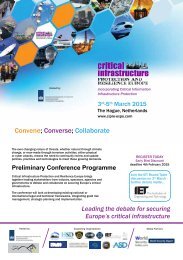Border Security Matters May 2014
Border Security Matters, the newsletter of BORDERPOL, The World Border Organization
Border Security Matters, the newsletter of BORDERPOL, The World Border Organization
You also want an ePaper? Increase the reach of your titles
YUMPU automatically turns print PDFs into web optimized ePapers that Google loves.
Port <strong>Security</strong>: The Front Line<br />
Once upon a time commercial ports only had to deal with three key threats on a daily basis - theft,<br />
damage to goods and stowaways all of which have the potential to cause considerable financial damage<br />
to stakeholders but were identifiable and manageable. The contemporary port is subject to a far<br />
wider range of threats including the possibility of terrorist attack and has to respond accordingly while<br />
managing and responding to a plethora of local, national and international legislative requirements.<br />
The diversity of responses, systems and processes to tackle each separate threat combined with the<br />
demands of compliancy has made the job of the Port Facility <strong>Security</strong> Officer (PFSO) onerous to the<br />
point of breaking.<br />
<strong>Security</strong> expert and former Chairman of the <strong>Security</strong> Development Board Rotterdam Port, Henk<br />
van Unnik, explains how a lack of cohesion has resulted in the current scenario and that a solution<br />
to the problem has been developed through the <strong>Security</strong> UPgrade for PORTs (SUPPORT) research<br />
& development project which is part-funded by the European Commision’s FP7 <strong>Security</strong> Research<br />
Programme. He explains how the appropriate management of resources can be co-ordinated and<br />
deployed to improve efficiency, effectiveness and port security.<br />
relaxation of border security between<br />
mainland-European countries in 1995,<br />
there are still major variations between<br />
different facilities. Some of this can be<br />
attributed to experience, some is driven<br />
by national or regional culture but some<br />
is due to the way legislation has been<br />
applied.<br />
With 90% of EU’s external trade and<br />
40% of internal trade transported by<br />
ship, the contemporary sea port is a vital<br />
cog in the massive machine that is 21st<br />
Century commerce. Unsurprisingly, port<br />
infrastructure and the 3.5 billion tonnes<br />
of freight that flows through EU facilities<br />
are vital to maintaining both global<br />
and individual countries’ economic<br />
wellbeing.<br />
The potential threats to port security<br />
come on many different levels from a<br />
range of groups and individuals with<br />
very different aims and objectives. Theft,<br />
fraud, corruption, drugs trafficking<br />
and people trafficking are all major<br />
issues for port security, especially when<br />
their motivation can be traced back to<br />
organised crime or terrorist groups.<br />
The combination of sophisticated<br />
organised crime, the heightened risk of<br />
terrorist activity and the ongoing threat<br />
of low level crime ensures that ports<br />
are under threat 24 hours per day, 365<br />
days per year. Well organised criminal<br />
gangs now have access to enough<br />
money, knowledge and skills to develop<br />
considerably more complex modus<br />
operandi. Where in the past, criminal<br />
organisations would use bribery or<br />
extortion to secure access, information<br />
or control of a particular shipment,<br />
recently there has been a move to bypass<br />
the human element and hijack the<br />
technology. Recent events at a Northern<br />
European port have demonstrated<br />
how easily a fully automated logistics<br />
chain can be manipulated if security is<br />
breached. Rather than having to run<br />
the risk of ‘stealing’ a container and<br />
getting through port security, or leaving<br />
a trail of names or addresses that can<br />
be followed up by law-enforcement<br />
agencies later, cybercrime ensures that<br />
all the key physical checks appear 100%<br />
legitimate at the dock gate, but can be<br />
wiped clean electronically, removing all<br />
trace. Faced with such innovative and<br />
complex criminal activity, port security<br />
needs to raise its game.<br />
While the baseline level of port security<br />
has certainly improved since the<br />
The legislation that defines port<br />
security is the International Maritime<br />
Organisation’s (IMO) International Ship<br />
and Port facility <strong>Security</strong> code (ISPS)<br />
which, in turn, is part of the Safety of Life<br />
at Sea (SOLAS) regulations. Developed<br />
in the aftermath of the September 11th<br />
terrorist attacks, the ISPS regulates<br />
security on-board ships, as well as<br />
inside ports and terminals which receive<br />
seagoing vessels on international<br />
voyages. The ethos of the ISPS code<br />
is very preventive and includes a<br />
requirement for both vulnerability<br />
and threat assessments to be carried<br />
out. Risks and vulnerabilities are very<br />
different when considering a container,<br />
bulk or passenger terminal and so<br />
all assessments must be specific and<br />
bespoke. The ISPS code also specifies<br />
a basic security framework including<br />
monitoring and controlling access,<br />
monitoring the activities of people and<br />
cargo, the preparation of specific ship<br />
and Port Facility <strong>Security</strong> Plans and the<br />
appointment of Ship <strong>Security</strong> Officers<br />
and a Port Facility <strong>Security</strong> Officer<br />
(PFSO).<br />
Across the European Union (EU), the<br />
ISPS code is supported by European<br />
Commission Directive 725. While<br />
identical to the ISPS code in content<br />
and a mandatory piece of pan-European<br />
legislation, Directive 725 only requires<br />
member states to achieve a particular<br />
<strong>Border</strong> <strong>Security</strong> <strong>Matters</strong><br />
www.borderpol.org page 16













